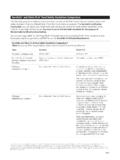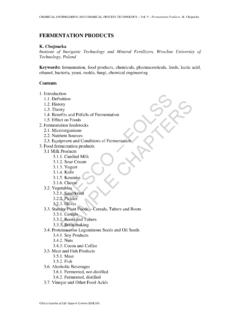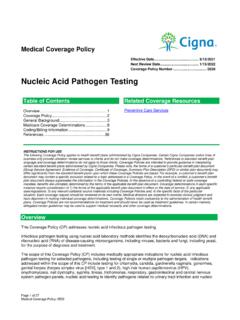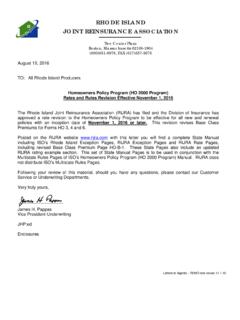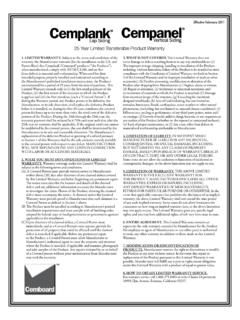Transcription of Glossary - ServSafe
1 2012 National Restaurant Association Educational Foundation (NRAEF). All rights reserved. Excerpted from ServSafe Manager Book, 6th may print one copy of this document for your personal use; otherwise, no part of this document may be reproduced, stored in a retrieval system, distributed or transmitted in any form or by any means electronic, mechanical, photocopying, recording, scanning or otherwise, except as permitted under Sections 107 and 108 of the 1976 United States Copyright Act, without prior written permission of the is a registered trademark of the NRAEF, used under license by National Restaurant Association Solutions, LLC.
2 The logo appearing next to ServSafe is a trademark of the National Restaurant 1208 Page 1 of 15 AAcidityLevel of acid in a food. An acidic substance has a pH below Foodborne microorganisms typically do not grow in highly acidic food, while they grow best in food with a neutral to slightly acidic managerial controlFood safety management system designed to prevent foodborne illness by addressing the five most common risk factors identified by the Centers for Disease Control and Prevention (CDC).Air curtainsDevices installed above or alongside doors that blow a steady stream of air across an entryway, creating an air shield around open doors.
3 Insects avoid them. Also called air doors or fly gapAir space used to separate a water-supply outlet from any potentially contaminated source. The air space between the floor drain and the drainpipe of a sink is an example. An air gap is the only completely reliable method for preventing suppliersSuppliers that have been inspected, are able to provide an inspection report, and that meet applicable local, state, and federal reverse flow of contaminants through a cross-connection into a drinkable water system. It occurs when the pressure in the drinkable water supply drops below the pressure of the contaminated , living microorganisms that can spoil food and cause foodborne illness.
4 Bacteria present in food can quickly multiply to dangerous levels when food is incorrectly cooked, held, or reheated. Some form spores that can survive freezing and very high Manager Online Glossary 2012 National Restaurant Association Educational Foundation (NRAEF). All rights reserved. Excerpted from ServSafe Manager Book, 6th may print one copy of this document for your personal use; otherwise, no part of this document may be reproduced, stored in a retrieval system, distributed or transmitted in any form or by any means electronic, mechanical, photocopying, recording, scanning or otherwise, except as permitted under Sections 107 and 108 of the 1976 United States Copyright Act, without prior written permission of the is a registered trademark of the NRAEF, used under license by National Restaurant Association Solutions, LLC.
5 The logo appearing next to ServSafe is a trademark of the National Restaurant 1208 Page 2 of 15 Bacterial growthReproduction of bacteria by splitting in two. When conditions are favorable, bacterial growth can be rapid doubling the population as often as every twenty minutes. Their growth can be broken down into four phases: lag phase, log phase, stationary phase, and death stemmed thermometerThe most common and versatile type of thermometer, measuring temperature through a metal probe with a sensor in the end. Most can measure temperatures from 0 F to 220 F ( 18 C to 104 C) and are accurate to within 2 F ( 1 C). They are easily contaminantsMicroorganisms, such as viruses, bacteria, parasites, and fungi, as well as toxins found in certain plants, mushrooms, and seafood, that have contaminated toxinsPoisons produced by pathogens, plants, or animals.
6 They can also occur in animals as a result of their chillerEquipment designed to cool food quickly. Many are able to cool food from 135 F to 37 F (57 C to 3 C) within 90 of ensuring that a thermometer gives accurate readings by adjusting it to a known standard, such as the freezing point or boiling point of who carry pathogens and infect others, yet never get sick for Disease Control and Prevention (CDC). Agencies of the Department of Health and Human Services that investigate foodborne-illness outbreaks, study the causes and control of disease, publish statistical data, and conduct the Vessel Sanitation contaminantsChemical substances, such as cleaners, sanitizers, polishes, machine lubricants, and toxic metals that leach from cookware and equipment, which have contaminated Manager Online Glossary 2012 National Restaurant Association Educational Foundation (NRAEF).
7 All rights reserved. Excerpted from ServSafe Manager Book, 6th may print one copy of this document for your personal use; otherwise, no part of this document may be reproduced, stored in a retrieval system, distributed or transmitted in any form or by any means electronic, mechanical, photocopying, recording, scanning or otherwise, except as permitted under Sections 107 and 108 of the 1976 United States Copyright Act, without prior written permission of the is a registered trademark of the NRAEF, used under license by National Restaurant Association Solutions, LLC. The logo appearing next to ServSafe is a trademark of the National Restaurant 1208 Page 3 of 15 Chemical hazardsChemical substances that can contaminate food, such as cleaners, sanitizers, polishes, machine lubricants, and toxic metals, that leach from cookware and sanitizingUsing a chemical solution to reduce the number of microorganisms on a clean surface to safe levels.
8 Items can be sanitized by immersing in a specific concentration of sanitizing solution for a required period of time or by rinsing, swabbing, or spraying the items with a specific concentration of sanitizing used chemical sanitizer due to its low cost and effectiveness. It kills a wide range of of visible dirt. It refers only to the appearance of a that remove food, dirt, rust stains, minerals, or other deposits from of removing food and other types of dirt from a surface, such as a countertop or amount of sanitizer to water measured in parts per million (ppm). The concentration of sanitizer affects the effectiveness of the sanitizer of harmful substances in food.
9 Some food safety hazards occur naturally, while others are introduced by humans or the actionPredetermined step taken when food does not meet a critical control points (CCPs)In a HACCP system, the points in the process where you can intervene to prevent, eliminate, or reduce identified hazards to safe Manager Online Glossary 2012 National Restaurant Association Educational Foundation (NRAEF). All rights reserved. Excerpted from ServSafe Manager Book, 6th may print one copy of this document for your personal use; otherwise, no part of this document may be reproduced, stored in a retrieval system, distributed or transmitted in any form or by any means electronic, mechanical, photocopying, recording, scanning or otherwise, except as permitted under Sections 107 and 108 of the 1976 United States Copyright Act, without prior written permission of the is a registered trademark of the NRAEF, used under license by National Restaurant Association Solutions, LLC.
10 The logo appearing next to ServSafe is a trademark of the National Restaurant 1208 Page 4 of 15 Critical limitIn a HACCP system, the minimum or maximum limit a critical control point (CCP) must meet in order to prevent, eliminate, or reduce a hazard to an acceptable link through which contaminants from drains, sewers, or other wastewater sources can enter a drinkable water supply. A hose connected to a faucet and submerged in a mop bucket is an transfer of an allergen from a food containing an allergen to a food that does not contain the when microorganisms are transferred from one food or surface to markingA date on ready-to-eat TCS food held for more than 24 hours indicating by when the food must be sold, eaten, or thrown detergents, often called degreasers.



